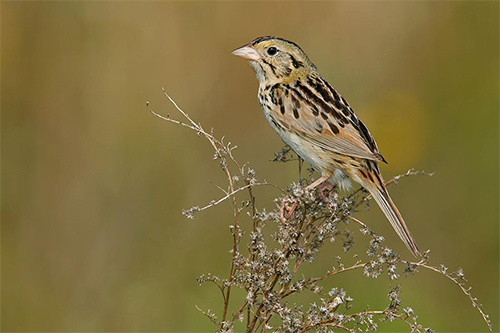Henslow’s Sparrow

Species information
The following is a report on progress made towards the protection and recovery of Henslow’s Sparrow, (Ammodramus henslowii) in Ontario from 2007 to 2020, based on Ontario’s species-specific recovery policy. This report meets the legislative requirement for a review of progress under the Endangered Species Act, 2007 (ESA or “the Act”). Henslow’s Sparrow is listed as endangered on the Species at Risk in Ontario (SARO) List under the ESA.
Henslow’s Sparrow has been classified as a species at risk since 1994, under the Endangered Species Act, R.S.O. 1990. It was originally classified as an endangered species and was listed as such under the ESA when it came into force in June 2008.
Henslow’s Sparrow has been protected from being killed, harmed, harassed, captured or taken since 1994.
In addition, the habitat of Henslow’s Sparrow has been protected from being damaged or destroyed since 2008.
Habitat protection for this species is based on the general habitat definition in the Act. A general habitat description for Henslow’s Sparrow was developed in 2013 and provides greater clarity on the area of habitat protected based on the general habitat definition in the Act.
The species-specific recovery policy for Henslow’s Sparrow, known as the Government Response Statement (GRS), was published in 2016 and includes the government’s recovery goal for the species and the actions and priorities it intends to lead or support to help achieve that goal. The GRS considers science advice provided in the recovery strategy, when developing recovery actions for the species. As legislated in the Act, the purpose of this review is to report on progress made towards implementing the protection and recovery actions in the GRS. The review can also help identify opportunities to adjust and adapt the implementation of protection and recovery actions to achieve the recovery goal for the species.
Further information about Henslow’s Sparrow, including the threats that it faces, and actions being taken to help protect and recover this species is available on the Government of Ontario webpage for Henslow’s Sparrow. A summary on the progress towards the protection and recovery of Henslow’s Sparrow and an annual update on the broader species at risk program (i.e. the Introduction to the 2021 Review of Progress report) is available on the Review of Progress towards the Protection and Recovery of Ontario’s Species at Risk webpage.
Snapshot: Progress towards the protection and recovery of Henslow’s Sparrow
Progress towards meeting the recovery goal
- The recovery goal in the Government Response Statement (GRS) for Henslow’s Sparrow in Ontario is to “encourage natural increases in the number of breeding pairs and support the expansion of the species to suitable breeding habitat in the historical distribution of Ontario, where feasible”.
- Progress has been made towards implementing all of the government-led actions and all of the government-supported recovery objectives and several of the associated actions. Examples of progress include:
- conducting presence/absence surveys for Henslow’s Sparrow at areas with suitable habitat across the historical distribution over multiple years
- supporting the securement of suitable habitat for Henslow’s Sparrow through existing land securement and stewardship programs
- In alignment with the GRS, greater efforts are needed to coordinate efforts and share information with other jurisdictions, including the federal government and partners in the United States, to monitor current populations, understand potential range contraction across the continent and increase knowledge of threats faced by the species. Greater efforts are also needed to develop and implement multi-year population monitoring programs for Henslow’s Sparrow at recent and newly-reported breeding locations in Ontario.
Occurrences and distribution
- Henslow’s Sparrow was historically widely distributed across southern Ontario, with an estimated range of approximately 3,400 square kilometres based on recent observations.
- The Natural Heritage Information Centre (NHIC) has received over 800 records of the species based on observations made between 1898 and 2019, and 469 of these records contain evidence of nesting activity.
Government-supported stewardship projects
- Through the Species at Risk Stewardship Program, the Government of Ontario has enabled its stewardship partners to conduct 46 projects (by providing $3,185,675 in funding) that have supported the protection and recovery of Henslow’s Sparrow. One project focused exclusively on Henslow’s Sparrow, while the other 45 projects focused on multiple species at risk, including Henslow’s Sparrow.
- The government’s support helped its stewardship partners to involve 1,466 individuals who volunteered 42,005 hours of their time towards protection and recovery activities for species at risk, including Henslow’s Sparrow. The estimated value of these voluntary contributions, as well as additional funding and in-kind support, is $9,589,645.
- Stewardship partners reported that through their actions 2,947 hectares of habitat were enhanced for Henslow’s Sparrow and other species at risk that inhabit the same ecosystem.
- Stewardship partners reported providing outreach on multiple species at risk, including Henslow’s Sparrow, to 109,867 individuals.
Supporting human activities while ensuring appropriate support for species recovery
- The Government of Ontario has issued 13 ‘protection or recovery’ permits under clause 17(2)(b) of the Endangered Species Act, 2007 (ESA) for this species.
- Thirty-nine activities have been registered for the species. The activities were registered under ‘Notice of drainage works’ (section 23.9), ‘Ecosystem protection’ (section 23.11), ‘Threats to health and safety, not imminent’ (section 23.18), and ‘Wind facilities’ (section 23.20) under Ontario Regulation 242/08 of the ESA.
Reporting on the progress towards the protection and recovery of Henslow’s Sparrow
Recovery goal
The government’s goal for the recovery of Henslow’s Sparrow is to encourage natural increases in the number of breeding pairs and support the expansion of the species to suitable breeding habitat in the historical distribution of Ontario, where feasible.
The implementation of government-led and government-supported actions demonstrates progress towards reaching the desired objectives and the recovery goal set out in the GRS.
Progress towards implementing government-led actions
Progress has been made towards implementing all government-led actions identified in the GRS. Common actions for the government to lead as it works towards achieving a species’ recovery goal include:
- Educate other agencies and authorities involved in planning and environmental assessment processes on the protection requirements under the ESA.
- Encourage the submission of Henslow’s Sparrow data to the Government of Ontario’s central repository at the Natural Heritage Information Centre.
- Undertake communications and outreach to increase public awareness of species at risk in Ontario.
- Protect the Henslow’s Sparrow and its habitat through the ESA. Continue to implement and enforce the species-specific habitat description for Henslow’s Sparrow.
- Encourage collaboration and establish and communicate annual priority actions for government support in order to reduce duplication of efforts.
Additionally, the government has directly undertaken the following species-specific actions:
- Establish strategic targets for the creation, maintenance or enhancement of grassland habitat through stewardship initiatives.
- Continue to implement vegetation management plans for provincially protected areas that include monitoring and vegetation management to maintain suitable habitat conditions and natural features for Henslow’s Sparrow, where appropriate.
Key progress made towards implementing these actions is described in the following sections.
To improve the resilience of natural ecosystems, the Ontario government is committed to strengthening and expanding grassland habitats by implementing the province’s Grassland Stewardship Initiative (GSI, or Initiative) that supports on-farm conservation activities to benefit grassland birds at risk, primarily Eastern Meadowlark and Bobolink.
The government identified Forests Ontario to initiate and administer the Government of Ontario’s GSI. The Initiative provides financial incentives to landowners to create, maintain and enhance grassland habitats.
At the outset of this work Forests Ontario:
- created the brand name Grasslands Ontario, which is the division of Forests Ontario that is leading implementation of the GSI
- identified and worked with partners and delivery agents
- coordinated and established agreements
- collaborated with the Ontario government to establish strategic targets and monitoring outcomes to assess habitat quality and population status to be used as part of the effectiveness monitoring for both habitat and the species
Over the course of the first two years of initial on-the-ground implementation of the Initiative (2018 and 2019), Grasslands Ontario engaged and registered participants and supported restoration of 435 hectares of high‐quality grassland habitat across Ontario. In addition to this initial progress toward on-the-ground GSI implementation, the province has supported dozens of grassland-related projects through the Species at Risk Stewardship Program which have contributed to the protection and recovery of grassland species at risk. Partners receiving provincial species at risk stewardship funding have reported that they have enhanced nearly 4,000 hectares of habitat that will benefit multiple species at risk.
The province continues to work towards restoring grassland habitat across Ontario, primarily through the provision of funding support through the Species at Risk Program (SARSP) to Forests Ontario to lead the delivery of the GSI. The GSI funding has supported (and will continue to support) partners in enhancing habitat by removing invasive species and mowing vegetation, maintaining habitat by delaying harvest of crops to promote nesting success, and creating habitat by planting appropriate seed mixes. The initial efforts of the GSI have focused primarily on the establishment and early implementation of the program.
This demonstrates progress towards the government commitments to create, maintain and enhance grassland habitats as outlined in the Henslow’s Sparrow GRS to support the recovery of the species.
Ontario Parks also continues to manage habitat of species at risk as feasible to maintain ecological integrity and minimize the threat of recreational pressures and impacts.
Occurrences and distribution
In Ontario, the historical range of Henslow’s Sparrow is considered to be southern Ontario, north to Barrie and Ottawa and east to at least Morrisburg. However, the breeding range has contracted substantially since the 1950s. Given the species’ broad distribution, the species’ occurrence information has been assessed at a landscape scale using 10 by 10 kilometre grid “squares” to approximate the species’ distribution. The squares were used to estimate where the species has been recently observed (i.e., has been observed within the past 20 years) as well as squares where the species is considered historical.
Using this approach, the species has been recently observed in 34 squares, and there remain 63 additional squares that contain historical observations of the species. This equates to a potential range
The government’s central repository at the NHIC, has received nearly 800 records of Henslow’s Sparrow. The records are based on observations between 1898 and 2019, and 469 of these records contain evidence that the birds observed may have been nesting near where the observations were recorded. Based on records since 2008, the species has been observed in locations associated with 10 squares in which it was not previously known to occur, and the species’ presence has been re-confirmed in 7 additional squares. There is no information on site fidelity for Canada, but Henslow’s Sparrows in the United States generally exhibit relatively low breeding and wintering site fidelity (COSEWIC, 2011). Data received since 2008 has allowed NHIC to identify 20 specific locations where nesting may have historically occurred, and 14 where recent breeding was documented.
New records of the species’ estimated distribution are most likely the result of increased search effort and education about Henslow’s Sparrow, and represents increased knowledge on the distribution of the species rather than actual range expansion. Efforts to engage citizen scientists in collecting data for this species have increased, with an assortment of programs and tools available for observations to be submitted and confirmed. This includes eBird, a program that collects an assortment of data on birds submitted by users, and shares this data with other agencies, such as the NHIC.
It is possible that there are observations of Henslow’s Sparrow that have not been submitted to the government. Encouraging the submission of observations of this species is included in the GRS as a government-led action. Submission of species observations increases our knowledge of where they occur and can play an important role in assessing the viability of species populations.
Everyone is encouraged, or may be required by an authorization or approval, to submit observations of Henslow’s Sparrow, and any other species at risk, to the NHIC for incorporation into the provincial record of observations. Observations may now be submitted to NHIC via the Rare Species of Ontario project in iNaturalist or through eBird.
-
79observations of this species were submitted to the NHIC since 2008
Government-supported stewardship projects
An important government-led action in the GRS for Henlow’s Sparrow is to support partners to undertake activities to protect and recover the species. Through the Species at Risk Stewardship Program the government has supported 46 projects ($3,185,675) designed to contribute to the protection and recovery of Henlow’s Sparrow
1,466 individuals volunteered 42,005 hours of their time towards protection and recovery activities for multiple species at risk, including Henslow’s Sparrow, which has an estimated value of $6,987,548. Partners also reported that through both their efforts and the efforts of their volunteers to implement GRS, they were successful in enhancing 2,947 hectares of habitat that will benefit multiple species at risk, including Henslow’s Sparrow. In addition, stewardship partners reported providing ecosystem-based outreach on multiple species, including Henslow’s Sparrow, to 109,867 individuals.
The remainder of this section highlights five projects supported through the Species at Risk Stewardship Program as well as the corresponding government-supported recovery actions for the species.
Many projects focussed on restoring tallgrass prairie ecosystems, the main habitat of Henslow’s Sparrow. In particular, the Couchiching Conservancy enhanced over 140 hectares of suitable habitat for grassland species, including Henslow’s Sparrow. This included installing fencing to exclude cattle to improve water quality of nearby streams and enhance grassland habitat conditions. In addition, Couchiching Conservancy promoted voluntary stewardship of grassland species at risk habitats on private lands, ongoing securement and recovery actions, and habitat protection. In the decade since 2011, additional patches of grassland have been enhanced for grassland species on the Carden Alvar, and annual monitoring of nesting birds has taken place. However, the only documented occurrence of Henslow’s Sparrow associated with this particular area was in late July, 2016, when an individual singing bird was seen by multiple observers over several weeks on a Couchiching Conservancy property. This bird was thought to be a non-breeding male.
In 2010, Tallgrass Ontario created several tallgrass prairie seed producing sites to make seed available to partners to restore tallgrass communities across southern Ontario, which will directly benefit Henslow’s Sparrow. In 2010 and 2014, the Prince Edward Point Bird Observatory undertook avian species at risk surveys in and around the Prince Edward County South Shore Important Bird and Biodiversity Area. No Henslow’s Sparrows were recorded during surveys in either year, even though the survey sites included appropriate habitat, further highlighting the rarity of this bird. However, in 2018, the Species at Risk Farm Incentive program, funded by the Species at Risk Stewardship Program reported observing five Henslow’s Sparrow’s on farms in southern Ontario.
Species at Risk Stewardship Program
-
 46
46projects included Henslow's Sparrow
-
 1
1project for Henslow's Sparrow exclusively
-
 $3,185,675
$3,185,675for projects that included Henslow's Sparrow
-
 $9,589,645
$9,589,645in additional funding and in-kind support
-
 1,466
1,466volunteers
-
 42,005
42,005volunteer hours
-
 109,867
109,867people received outreach
-
 2,947
2,947hectares of habitat enhanced
Supporting human activities while ensuring appropriate support for species recovery
Supporting partners through authorizations and their associated conditions is an important government-led action.
Thirteen permits have been issued for Henslow’s Sparrow since the species has been protected under the ESA, all of which were ‘protection or recovery’ (17(2)(b)) permits. ‘Protection or recovery’ permits are issued if the purpose of the activity is to assist in the protection or recovery of a species at risk. Of the 13 permits, all were issued for multiple species, including Henslow’s Sparrow. These permits enabled the collection of deceased specimens and the medical treatment of injured birds.
Thirty-nine activities that may affect Henlow’s Sparrow or its habitat have been registered for the purposes of Ontario Regulation 242/08 under the ESA. Twenty activities were registered under ‘Notice of drainage works’ (section 23.9), three activities were registered under ‘Ecosystem Protection’ (section 23.11), 14 activities were registered under ‘Threats to Threats to human health or safety, non-imminent’ (section 20.18), and two activities were registered under ‘Wind facilities’ (section 23.20). These registrations require the registrant to comply with all conditions of the regulation, such as:
- ensuring that reasonable steps are taken to minimize adverse effects on the species and its habitat
- ensuring that any species observations are submitted to the NHIC
- refraining from carrying out work during sensitive periods for the species (e.g., breeding season) if possible
-
13protection or recovery permits
-
39registrations
Progress towards implementing government-supported actions
Government-supported actions are organized under overarching recovery objectives. Progress has been made towards achieving all government-supported recovery objectives and implementing several of the associated actions identified in the GRS for Henslow’s Sparrow.
Objective: Increase knowledge of Henslow’s Sparrow distribution, abundance, habitat, and the significance of threats.
- Action No. 1 (High Priority) - Develop and implement multi-year population monitoring programs for Henslow’s Sparrow at recent and newly-reported breeding locations in Ontario to:
- estimate the number of individuals present and breeding in Ontario
- monitor breeding productivity and survivorship
- identify and describe key characteristics of breeding habitat including grassland size
- Action No. 2 - Conduct presence/absence surveys for Henslow’s Sparrow at areas with suitable habitat across the historical distribution over multiple years.
- Action No. 3 - Coordinate efforts and share information with other jurisdictions, including the federal government and partners in the United States, to monitor current populations, understand potential range contraction across the continent and increase knowledge of threats faced by the species.
Under this objective, initial progress has been made towards implementing Action No. 2.
Action No. 2 has been initially implemented through projects supported by the Species at Risk Stewardship Program. A project team conducted Henslow’s Sparrow presence/absence surveys in multiple years in suitable habitat, though this species was never observed. Another project that took place later, however did observe the species in five instances.
Objective: Increase the quality and amount of suitable habitat for Henslow’s Sparrow through increased public awareness and stewardship in Ontario.
- Action No. 4 (High Priority) - Develop, promote and implement best management practices for the restoration, enhancement and management of Henslow’s Sparrow habitat in Ontario such as increasing the size of grassland patches and managing vegetation appropriately for habitat usage by the species. Coordinate efforts as appropriate with other grasslands initiatives.
- Action No. 5 - As opportunities arise, support the securement of suitable habitat for Henslow’s Sparrow through existing land securement and stewardship programs.
Under this objective, initial progress has been made towards implementing Action No. 4 and progress has been made towards implementing Action No. 5.
Action No. 4 and Action No. 5 have been implemented through several projects supported by the Species at Risk Stewardship Program. Multiple projects have enhanced grassland patches (including the management of vegetation) and secured land containing suitable habitat for Henslow’s Sparrow. Several projects included the sharing of advice to landowners and farmers on species at risk habitat management and vegetation community management, benefiting Henslow’s Sparrow and other species.
Summary of progress towards meeting the recovery goal
The recovery goal for Henlow’s Sparrow is “to encourage natural increases in the number of breeding pairs and support the expansion of the species to suitable breeding habitat in the historical distribution of Ontario, where feasible”. Effort made towards the government-led and government-supported actions has helped to make progress towards this goal. For example, the Species at Risk Stewardship Program has supported the securement and enhancement of suitable habitat for Henslow’s Sparrow through existing land securement and stewardship programs.
Recommendations
As stated in the GRS, this review of progress can be used to help identify whether adjustments to the implementation of GRS actions are needed, to achieve the protection and recovery of the species. Based on progress to date, the overall direction provided in the GRS for Henslow’s Sparrow, particularly the implementation of actions identified as high priority, should continue to guide protection and recovery of the species.
Although initial progress has been made towards the actions to conduct presence/absence surveys for Henslow’s Sparrow at areas with suitable habitat across the historical distribution over multiple years, further work is required to fully implement this action.
Relative to actions that have received a stronger level of support, the following actions have received less attention and are identified for consideration in future work towards the protection and recovery of the species:
- Action No. 1 (High Priority) - Develop and implement multi-year population monitoring programs for Henslow’s Sparrow at recent and newly-reported breeding locations in Ontario to:
- estimate the number of individuals present and breeding in Ontario
- monitor breeding productivity and survivorship
- identify and describe key characteristics of breeding habitat including grassland size
- Action No. 3 - Coordinate efforts and share information with other jurisdictions, including the federal government and partners in the United States, to monitor current populations, understand potential range contraction across the continent and increase knowledge of threats faced by the species.
Protecting and recovering Henslow’s Sparrow will continue to be a shared responsibility that will require the involvement of many individuals, organizations and communities. Financial support for the implementation of actions may be available through the Species at Risk Stewardship Program. The government can also advise if any authorizations under the ESA or other legislation may be required to undertake a project. By working together, progress can continue to be made towards protecting and recovering Henslow’s Sparrow in Ontario.
References
- COSEWIC. 2011. COSEWIC assessment and status report on the Henslow’s Sparrow Ammodramus henslowii in Canada. Committee on the Status of Endangered Wildlife in Canada. Ottawa. X + 37pp
Footnotes
- footnote[1] Back to paragraph A population is considered historical if it has not been recorded within the last 20 years. Historical populations may still exist, but updated information is not available.
- footnote[2] Back to paragraph A potential range of the species is estimated based on a 10 by 10 kilometre square grid where observations of the species have occurred. It is not representative of the extent of suitable habitat of the species, nor the total area that the species is occupying.
- footnote[3] Back to paragraph Some projects supported through the Species at Risk Stewardship Program may require a 17(2)(b) permit in order to carry out the project. As a result, some 17(2)(b) permits indicated in this report may have been issued to authorize those projects.